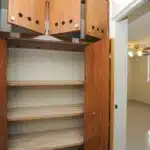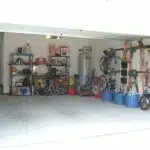As a professional organizer and decluttering expert, I have seen firsthand the impact that clutter has on people’s lives. It can be overwhelming, stressful, and even debilitating at times. One area that often causes a lot of clutter is our closets, specifically our clothes. We accumulate so many items over time and before we know it, our once-organized closet is now bursting at the seams. In this article, I will share some tips and strategies for how to declutter the clothes in your closet and create a more organized space that brings you peace and clarity.
Firstly, it’s important to understand why we hold onto clothes that no longer serve us. Often times we attach sentimental value to items or hold onto them with the hope of one day fitting into them again. However, holding onto these items only adds unnecessary clutter to our closet and can hinder us from moving forward in our lives. By learning how to let go of clothing that no longer serves us, we can make room for new opportunities and experiences in our lives. In the following paragraphs, I will discuss practical steps for how you can begin decluttering your closet and creating a more intentional wardrobe.
Understanding The Impact Of Clutter On Your Life
The clutter in your closet can have a significant impact on your life. It can cause you to feel overwhelmed and stressed, affecting your overall well-being. The Importance of minimalism cannot be overstated as it promotes simplicity and clarity. Minimalism helps to create a more organized space that enables you to focus on the essential things in your life.
Mindfulness in decision making is also critical when it comes to decluttering your closet. You need to make decisions based on what is necessary, important, and useful to you. When deciding which clothes to keep or discard, ask yourself whether you have worn them recently or if they hold sentimental value. If not, consider donating or selling them.
A cluttered closet can make it challenging to find what you need quickly and efficiently, causing frustration and wasting valuable time. A decluttered closet has several benefits that can help improve your life significantly. In the subsequent section about ‘the benefits of a decluttered closet,’ we will explore how a well-organized closet can save you time, reduce stress, and even save you money.
The Benefits Of A Decluttered Closet
As discussed in the previous section, clutter can have a significant impact on your life. One area where this is particularly true is your closet. A cluttered closet can make it difficult to find the clothes you need, leading to frustration and wasted time. It can also contribute to feelings of stress and overwhelm.
However, the benefits of a decluttered closet are numerous. Firstly, it allows you to adopt a more minimalist approach to your wardrobe. By simplifying your clothing collection, you’ll find that you’re able to focus on the pieces that truly matter to you – those that fit well, make you feel confident, and align with your personal style. This not only saves time and money but can also help reduce decision fatigue.
Another benefit of decluttering your closet is that it makes getting dressed in the morning much easier. With fewer options to choose from, you’ll be able to put together outfits more quickly and confidently. This can help boost your self-esteem while also saving time during busy mornings.
In order to reap these benefits, it’s important to set clear goals for your decluttering process. Whether you want to create a capsule wardrobe or simply get rid of items that no longer serve you, having a specific goal in mind will help guide your decisions and keep you motivated throughout the process. In the next section, we’ll explore some strategies for setting these goals and creating a plan for tackling your cluttered closet.
Setting Your Decluttering Goals
When it comes to decluttering your closet, setting achievable goals is key. A common mistake people make when starting the process is trying to tackle everything at once. This can lead to feeling overwhelmed and giving up before making any significant progress. Instead, break down the task into smaller, more manageable goals that you can realistically achieve.
To set achievable goals, start by assessing your current situation and deciding what you want to achieve. Do you want to have more space in your closet? Are there specific items of clothing you want to get rid of? Once you have a clear idea of what you want to accomplish, create a plan with actionable steps that will help you reach your goal. For example, if your goal is to have more space in your closet, one actionable step could be to remove all out-of-season clothing and store it elsewhere.
Tracking progress is also essential when setting decluttering goals. It allows you to see how far you’ve come and motivates you to keep going. Keep track of what you’ve accomplished each day or week and celebrate your successes along the way. Remember that decluttering takes time and effort, but the end result will be worth it.
- Visualize how much better you’ll feel with a clutter-free closet
- Think about how donating unused clothes can benefit others in need
- Consider the positive impact decluttering can have on mental health
- Imagine the sense of accomplishment from achieving your decluttering goals
With these tips for setting achievable goals and tracking progress in mind, let’s move on to assessing your wardrobe and deciding which items to keep or discard.
Assessing Your Wardrobe
- When assessing your wardrobe, it is important to determine which items should be purged and which should be kept.
- Once the purge is completed, wardrobe organization is the next step to ensure the clothing items are stored in a manner that promotes efficient use.
- To keep your wardrobe current, consider engaging in seasonal clothes swaps with friends, family, or neighbors.
- To maximize the effectiveness of your wardrobe, it is beneficial to review the items regularly and assess whether they are still relevant to your needs.
- Utilizing a wardrobe inventory checklist is a great way to stay organized and make sure that all items have been accounted for.
- To ensure a successful wardrobe assessment, consider setting aside a dedicated amount of time to review and organize your clothing items.
Purge Vs Keep
It can be challenging to declutter your wardrobe, especially when you have an emotional attachment to certain clothing items. However, it is essential to assess your closet and decide what to purge and what to keep. When evaluating your clothes, it is crucial to balance practicality with sentimentality.
Many people struggle with the concept of purging their clothing because they attach sentimental value to certain items. However, holding onto clothing solely for emotional reasons can quickly clutter your closet and make it difficult to find what you need. It’s important to evaluate each item objectively and consider if it serves a practical purpose in your life. For instance, if you haven’t worn a dress in two years but keep it because of the memories attached to it, consider taking a photo of the dress instead of keeping the actual garment.
On the other hand, some people may focus too much on practicality when assessing their wardrobe and overlook sentimental pieces that hold significant emotional value. While making practical decisions is necessary when trying to declutter your closet, it’s also essential not to dismiss items that genuinely bring joy or hold special meaning. If you’re unsure about whether or not an item deserves a place in your closet, ask yourself if you would repurchase the same piece today if given the chance. If the answer is yes, then perhaps keeping it is worth considering.
Wardrobe Organization
One crucial step in decluttering your wardrobe is to assess its current state and decide what items to keep or discard. This process involves evaluating each clothing piece objectively, considering both practicality and sentimentality. However, organizing your closet also plays a significant role in maintaining a minimalist wardrobe.
Start by doing a closet cleanout, removing all clothing items from your wardrobe and sorting them into piles of keep, donate, or toss. Once you’ve decided which pieces to keep, it’s time to organize them effectively. There are several ways to organize your closet, such as by color, season, or type of clothing item. Choose a method that works for you and stick with it.
Another effective way to maintain an organized wardrobe is to invest in storage solutions that fit your space and needs. You can use hangers, shelving units, dividers, and even an ottoman with storage space to help you stay organized. With an organized closet that holds only the clothes you love and wear regularly, getting dressed every day becomes more comfortable and enjoyable.
Seasonal Clothes Swaps
Assessing your wardrobe is a critical step towards creating a minimalist closet. As a professional organizer, I highly recommend doing a closet cleanout and sorting your clothes into piles of keep, donate, or toss. Once you’ve decided which pieces to keep, it’s essential to organize them effectively. One way to do this is by using the closet rotation method, where you only keep clothes that are appropriate for the current season and store the rest away.
Closet rotation involves swapping out seasonal clothes at regular intervals. This approach helps you maintain an uncluttered wardrobe while ensuring that you have enough clothes for each season. For example, during winter, you can store away summer clothes like shorts and tank tops and bring out warm clothing like sweaters and jackets. You can also use seasonal storage solutions like vacuum-sealed bags or storage boxes to keep your clothes safe from moisture and pests.
Incorporating closet rotation and seasonal storage solutions into your wardrobe assessment process can help you streamline your closet and make getting dressed easier. As a decluttering expert, I suggest evaluating each piece of clothing objectively before deciding whether to keep, donate or toss it. Then organize what remains using a system that works for you—whether by color, season or type of clothing item—to ensure that everything has its place in your minimalist wardrobe.
Sorting Your Clothes Into Categories
Now that you’ve emptied your closet, it’s time to sort your clothes into categories. The first category is clothing material. Separate your clothes into piles of cotton, wool, silk, and other materials. This step will help you identify which items require special care when washing or storing.
The second category is color coordination. Sort your clothes by color and group similar shades together. Not only will this make it easier to find what you’re looking for, but it will also help you identify any gaps in your wardrobe. For example, if you notice that you have a lot of blue shirts but no green ones, you may want to consider adding a green shirt to balance out your collection.
Once you’ve sorted your clothes by material and color, it’s time to make decisions on what to keep, donate, or discard. This can be a daunting task, but remember that the goal is not necessarily to get rid of as much as possible but rather to create a curated collection of items that serve you well. In the next section, we’ll discuss some tips for determining which items are worth keeping and how to responsibly dispose of those that aren’t.
Making Decisions On What To Keep, Donate, Or Discard
Have you ever found yourself staring at your closet, wondering what to do with all the clothes? Making decisions on what to keep, donate, or discard can seem daunting, but it doesn’t have to be. By using a few simple strategies, you can streamline the process of decluttering your wardrobe.
The first step in determining what to keep or donate is to assess the condition and fit of each item. If an item is damaged or no longer fits properly, consider donating it or tossing it out. However, if an item is still in good condition and fits well, it may be worth keeping. When deciding whether or not to keep an item, consider how often you wear it and if it serves a purpose in your current lifestyle.
When deciding whether to toss or repurpose an item, there are a few key factors to consider. If an item is stained or damaged beyond repair, tossing it out may be the best option. However, if an item has sentimental value or could be used for another purpose (such as turning old t-shirts into cleaning rags), repurposing may be a better choice. Ultimately, the decision of what to do with each item should come down to its usefulness and value in your life.
Tips for letting go of sentimental items will help you create space in your home and lead a more organized life. By using these techniques for decluttering your wardrobe and making decisions about what to keep or donate, you’ll be able to create a streamlined closet that reflects your true style and helps you feel confident and organized every day.
Tips For Letting Go Of Sentimental Items
After making the tough decisions of what to keep, donate, or discard, it’s time to focus on letting go of items that hold emotional attachment or sentimental value. Often, this is the most challenging part of decluttering clothes in your closet. It’s natural to feel attached to certain items because of memories associated with them or because they represent a specific time in our lives. However, holding onto clothes that don’t fit or aren’t practical for our current lifestyle can create unnecessary clutter and stress.
One strategy for letting go of sentimental clothing items is to take a photo of them before donating or discarding them. This way, you can still hold onto the memory without having the physical item taking up space in your closet. Another option is to repurpose the clothing item into something new and useful. For example, if you have a favorite t-shirt that no longer fits, consider turning it into a quilt or pillowcase.
It’s important to remember that letting go doesn’t mean forgetting about cherished memories. It simply means creating space for new experiences and opportunities in life. By focusing on the positive aspects of decluttering and finding creative ways to repurpose sentimental items, you’ll be able to clear out your closet and create a more organized and stress-free space. In the next section, we’ll explore strategies for dealing with clothes that don’t fit properly and how to make sure everything in your closet serves a purpose.
Strategies For Dealing With Clothes That Don’t Fit
When decluttering your closet, it’s common to come across clothes that no longer fit. It can be difficult to part with these items because of sentimental attachment or the hope of fitting into them again someday. However, holding onto clothes that don’t fit can take up valuable space in your closet and contribute to clutter.
One option for dealing with clothes that don’t fit is to explore tailoring options. You may have a piece of clothing that you love but no longer fits properly. Taking it to a tailor can allow you to make adjustments and continue wearing the item. This approach can be cost-effective compared to buying new clothes and also allows you to keep sentimental pieces in your wardrobe.
Alternatively, consider finding alternative uses for clothes that don’t fit. For example, an oversized shirt could be repurposed as a cover-up at the beach or a dress could be transformed into a skirt. Thinking creatively about how you can use these items outside of their original purpose can help reduce clutter in your closet while also giving new life to old favorites.
Now that you’ve addressed any clothes that don’t fit in your closet, it’s time to focus on organizing the remaining items. In the next section, we’ll explore strategies for creating an efficient and functional closet space where every item has its place.
Organizing Your Closet Space
Just like pruning a tree, decluttering your closet is an essential task that requires patience and strategy. You need to be in control of what stays and what goes. It’s time to take a step back and assess the clothes you own. Do they still serve their purpose? Are they relevant to your current lifestyle?
If you’re having trouble finding space in your closet, consider investing in space-saving hangers or closet organization hacks. For instance, using cascading hooks can help you store more clothes vertically, while drawer dividers can help separate different items like socks or underwear. These simple solutions can make a significant difference in creating more room for your wardrobe.
Creating a capsule wardrobe is another way to keep your closet organized and clutter-free. A capsule wardrobe consists of essential pieces that are versatile enough to mix and match with other items in your closet. Having fewer clothes may seem counterintuitive at first, but it makes getting dressed easier, saves money, and reduces the environmental impact of fast fashion. Remember: quality over quantity is key when building a capsule wardrobe.
Creating A Capsule Wardrobe
One effective way to declutter your closet is by creating a capsule wardrobe. A capsule wardrobe is a minimalist style of dressing that includes only essential and versatile pieces of clothing. With this approach, you can mix and match pieces to create different outfits without accumulating excess clothes. The key to building a capsule wardrobe is selecting items that fit your personal style and are appropriate for your lifestyle.
To begin, start by taking inventory of the clothes you currently have in your closet. Sort them into piles of what you love, what you wear often, and what you haven’t worn in months. Keep the items that fit well and make you feel confident; donate or sell the ones that don’t. Once you have identified the essential pieces, select additional items that can be mixed and matched with ease.
When selecting clothes for your capsule wardrobe, consider investing in high-quality basics like plain t-shirts, jeans, and blouses. These pieces can be dressed up or down depending on the occasion. Accessorizing with jewelry or scarves can also help elevate an outfit without adding bulk to your closet. By adopting a minimalist approach to dressing with a capsule wardrobe, you’ll not only reduce clutter but also save money in the long run.
Maximizing Your Space with Storage Solutions
Now that you’ve created a more streamlined wardrobe with a capsule approach, it’s time to maximize your space with storage solutions. One easy way to do this is by utilizing vertical space within your closet. Install shelves or hanging organizers to store folded clothes or shoes off the floor. Additionally, use slim hangers instead of bulky ones to maximize hanging space.
Another option is storing off-season clothes under the bed or in vacuum-sealed bags when not in use. This frees up valuable real estate in your closet while keeping items easily accessible when needed. Lastly, consider repurposing other household items for storage solutions such as using baskets or decorative boxes to store accessories or folded clothes.
By implementing these storage solutions, you can make the most of your closet space while keeping your capsule wardrobe organized and clutter-free.
Maximizing Your Space With Storage Solutions
- Evaluating closet space involves assessing the size, shape, and functionality of the space in order to determine how to best utilize the area.
- Utilizing storage containers to organize items within the closet can ensure that items are properly sorted and easy to access.
- Making room for hanging clothes may require removing items from the closet that are not used frequently and storing them in other areas of the home.
- To maximize the use of space within the closet, it is important to consider not only the items that are stored within the closet, but also the way they are stored.
- Hanging rods and shelves are two of the most common storage solutions for closets and can be used to maximize the use of the area.
- To ensure that items are properly stored and the closet remains organized, it is important to regularly evaluate the space and reorganize as necessary.
Evaluating Closet Space
Upon evaluating the closet space, it is important to take into consideration the dimensions of the space and the types of storage solutions that can be implemented. Maximizing space in a closet can be achieved by utilizing vertical space with hanging organizers or shelving units. Additionally, using slim hangers instead of bulky ones can free up more space for clothing items.
Closet organization tips include categorizing clothes by type and color, which not only creates a visually appealing aesthetic but also makes it easier to locate specific items. Another useful tip is to regularly purge old or unused clothing items to make room for new ones. This can be done by donating or selling clothes that no longer fit or are no longer in style.
Lastly, creating a functional layout within the closet can also maximize space and aid in organization. Grouping frequently worn items at eye level and less frequently worn items on higher shelves or lower racks can prevent overcrowding and create a more efficient use of space. Ultimately, evaluating closet space requires careful consideration of available storage solutions, effective organization techniques, and a commitment to regularly decluttering unwanted clothing items.
Utilizing Storage Containers
Maximizing closet space is a crucial aspect of maintaining an organized and functional home. In addition to utilizing vertical space and implementing effective organization techniques, utilizing storage containers can also be a valuable tool in maximizing space. By incorporating storage containers, homeowners can create a more streamlined and efficient use of closet space.
When it comes to choosing container types, homeowners have several options to consider. Clear plastic bins are a popular choice as they allow for easy visibility and organization of items. Fabric storage cubes are another option that can add texture and visual interest to the closet while providing ample storage space. Shoe organizers, hanging shelves, and drawer dividers are also useful container types that can keep items separated and easily accessible.
Incorporating organization methods within the storage containers is just as important as selecting the right type of container. Categorizing items by type or season can aid in quick identification and access to specific items. Labeling containers with clear descriptions or images can also save time and prevent clutter from accumulating over time. Ultimately, utilizing storage containers in conjunction with other organizational solutions can lead to a more efficient use of closet space while making it easier to maintain an organized living environment.
Making Room For Hanging Clothes
Maximizing your space with storage solutions is not just about using the right containers to store items. It also involves making the most of every inch of available space in your closet, including vertical and horizontal areas. One way to optimize your closet’s storage capacity is by maximizing hanging space. By doing so, you can accommodate more clothes and accessories without taking up valuable floor space.
To maximize hanging space, you need to think creatively about how to use every inch of your closet’s vertical area. One solution is to install additional rods or hooks that allow you to hang items at different heights. You can also use cascading hangers that let you hang multiple garments on a single hook, saving you valuable rod space. Additionally, adding shelves or cubbies above or below the rods can provide extra storage for folded garments, shoes or accessories.
When implementing creative storage solutions for hanging clothes, it’s essential to keep things organized and accessible. Use dividers or separate hangers to group similar items together, such as shirts or skirts. Labeling each section can make it easier for you to find what you need quickly while reducing clutter and confusion in your closet. With these strategies in mind, you can transform your cluttered closet into an organized and functional space that maximizes every inch of available storage capacity.
Maintaining Your Decluttered Closet
Maximizing Your Space with Storage Solutions is only the first step in decluttering your closet. The next step is to maintain organization through regular maintenance and seasonal rotation. This ensures that your closet remains tidy and functional over time.
Maintaining organization means keeping your closet free from clutter on a regular basis. Make it a habit to purge items that you no longer wear or need every few months. This includes anything that no longer fits, is out of style, or has been damaged beyond repair. If you find it difficult to let go of certain items, ask yourself if they truly serve a purpose in your life. If not, consider donating them to someone who may benefit from them.
Seasonal rotation is another crucial aspect of maintaining an organized closet. As the seasons change, swap out clothing items accordingly. This means storing bulky winter coats during the warmer months and bringing out lighter fabrics for spring and summer. Not only does this free up space in your closet, but it also allows you to see what you have and what you may need for the upcoming season.
As you continue to declutter your closet, consider repurposing or upcycling unwanted clothing instead of simply throwing it away. Old t-shirts can be turned into rags or used as cleaning cloths, while jeans can be cut into shorts or used as patchwork for other clothing items. By finding new uses for old clothing, you can reduce waste and give new life to items that would otherwise end up in a landfill.
Repurposing Or Upcycling Unwanted Clothing
While decluttering your closet, it’s important to consider how you can repurpose or upcycle unwanted clothing. This not only helps reduce waste but also gives your clothes a new life and purpose. Repurposing ideas include turning old t-shirts into cleaning rags, using old jeans to make a denim rug, or transforming an old sweater into a cozy pillow.
Upcycling projects offer even more opportunities for creativity and personalization. For example, you can turn an old dress shirt into a trendy crop top, use scraps of fabric to create unique patchwork designs on jeans, or transform an outdated skirt into a stylish tote bag. There are countless online resources and tutorials available for those looking for inspiration and guidance on upcycling projects.
By repurposing or upcycling unwanted clothing, you not only decrease the amount of waste going to landfills but also contribute to reducing the environmental impact of clothing production. Clothing production has a significant carbon footprint due to factors such as energy usage and water consumption. Therefore, finding ways to extend the life of our clothing can help mitigate these effects and create a more sustainable future for all.
Transition: Understanding the impact of clothing waste is crucial in creating a sustainable lifestyle. Let’s explore this topic in more detail next.
The Environmental Impact Of Clothing Waste
Reducing waste is a vital aspect of sustainable fashion, and clothing waste is one of the most significant environmental issues we face. Clothing production accounts for 10% of the world’s carbon emissions, and over 92 million tons of textile waste end up in landfills each year. The more we can reduce clothing waste, the more we can help our planet.
One way to reduce clothing waste is to declutter your closet regularly. When you have fewer clothes, you are more likely to wear them all, and they’ll last longer. You will also be less likely to make impulse purchases or buy clothes that don’t fit your style or lifestyle. When you do need to get rid of clothes, consider donating them rather than throwing them away.
Another way to reduce clothing waste is to invest in high-quality pieces that will last a long time. Fast fashion has become a significant contributor to the clothing waste problem because it encourages consumers to buy cheaply made clothes that won’t last long. Instead, look for well-made items that are timeless and versatile so that you can wear them for years to come.
- Did you know that washing your clothes less often can help reduce water consumption and extend their lifespan?
- Reusing old clothes by repurposing or upcycling them into new items reduces textile waste and saves resources.
- Consider renting or borrowing clothes for special occasions instead of buying something new that you may only wear once.
By reducing clothing waste and investing in sustainable fashion choices like quality over quantity, we can all play a part in protecting the environment. Celebrate your progress towards a more sustainable wardrobe by tracking how much money you’ve saved from not buying unnecessary items or how many pieces of clothing you’ve donated or repurposed. Remember that every small step counts towards making a big impact on our planet’s future.
Celebrating Your Accomplishments And Progress
After decluttering your closet and getting rid of the unnecessary clothes, it’s important to take a moment to celebrate the progress you’ve made. Recognize that this is no small feat; letting go of possessions can be difficult for many people. Take pride in the fact that you’ve taken a step towards simplifying your life and creating more space both physically and mentally.
In addition to celebrating progress, it’s crucial to adopt a mindset shift when it comes to acquiring new items. Instead of constantly buying new things, try to focus on what you already have and how you can make use of it. This not only saves money but also reduces clutter in the long run. Consider investing in quality pieces that will last longer rather than cheaper items that will need replacing frequently.
Remember that decluttering is an ongoing process, not a one-time event. It’s important to regularly assess your belongings and let go of anything that no longer serves you. By adopting a mindset shift towards minimalism, you’ll find yourself feeling lighter and more at ease with your surroundings. Celebrate each step along the way as you continue on this journey towards a simpler, more intentional life.
Conclusion
Clutter in our lives can cause stress, anxiety, and a feeling of being overwhelmed. One area where clutter tends to accumulate is in our closets. By decluttering our clothes, we can experience numerous benefits such as increased productivity, reduced stress levels, and improved mental clarity.
To begin the decluttering process, set achievable goals for yourself and assess your wardrobe by sorting your clothes into categories such as keep, donate or sell, and repurpose. It’s important to maintain your decluttered closet by regularly assessing and removing any items that no longer serve you. Additionally, consider repurposing or upcycling unwanted clothing to reduce waste.
The environmental impact of clothing waste cannot be ignored – according to the Environmental Protection Agency (EPA), 11.3 million tons of textiles were generated in 2018 alone. Celebrate your progress towards a decluttered closet by acknowledging the positive impact it has on both your life and the environment.
In conclusion, decluttering your closet is a process that requires time, effort and commitment but has numerous benefits for your well-being and the environment. As you embark on this journey remember that every small step counts towards achieving a more organized and sustainable lifestyle. So take charge of those hangers and let go of what no longer serves you – clear space for new beginnings!
Image Credits
- “Clothes Closet, overstuffed with clothes, Greenwood, Seattle, Washington, USA” by Wonderlane (featured)




















![How To Wash And Care For White Clothes 20 The only genuine borax soap cleanses hygienically saves the clothes and hands. 20 Mule-Team brand Boraxo white laundry soap [front]](https://green-life.blog/wp-content/uploads/2023/05/YDXLLCovnOjq-150x150.jpg.webp)








